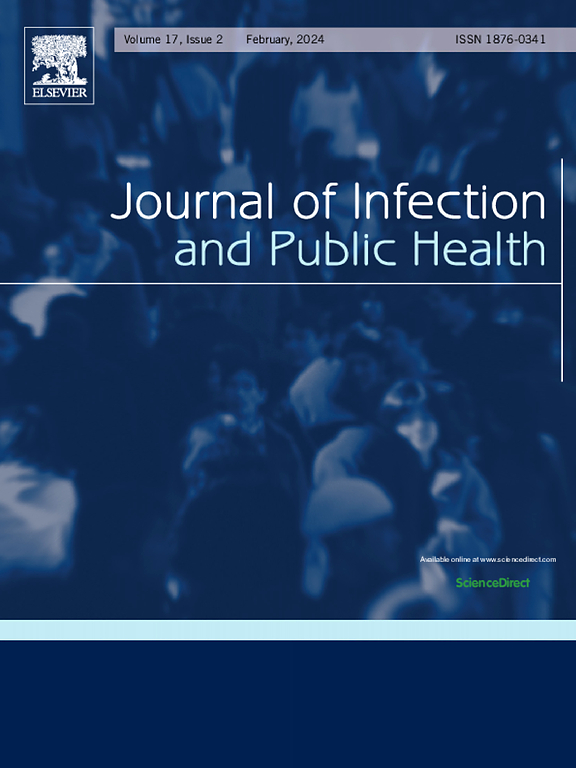Procedural and clinical risk factors of infective endocarditis – A nationwide case-control study in South Korea
IF 4
3区 医学
Q1 INFECTIOUS DISEASES
引用次数: 0
Abstract
Background
Infective endocarditis (IE) causes high mortality and morbidity, posing a significant burden on healthcare systems. Although the incidence of IE is rising globally, its risk factors, particularly procedure-related risks, remain unclear. This study aimed to investigate the clinical and procedural risk factors associated with IE using nationwide data from South Korea.
Methods
We analyzed data from the Korean National Health Insurance Service between 2003 and 2018. A total of 8487 patients with IE and 33,535 matched controls based on age, sex, and the Charlson Comorbidity Index were included. Procedural risk factors were categorized as dental, gastrointestinal, respiratory, and genitourinary, with analysis periods of 90 and 60 days for dental and other procedures, respectively. Logistic regression models were used to evaluate the associations, with statistical significance set at P < 0.05.
Results
Traditional risk factors including dialysis, immunosuppression, congenital heart disease, and valvular disease were significantly associated with IE. Additionally, invasive procedures, such as intravenous catheter insertion (odds ratio [OR], 18.94) and respiratory (OR, 4.05), gastrointestinal (OR, 3.09), and genitourinary procedures (OR, 3.97), were strongly associated with an increased risk of IE (all P < 0.001). Dental procedures without antibiotic prophylaxis were also associated with a higher risk of IE (OR, 1.19; P = 0.001), whereas those with prophylaxis were not (OR, 1.07; P = 0.256).
Conclusions
Both clinical factors and procedural interventions significantly contributed to the risk of IE. Our findings support the need for expanded preventive strategies, particularly considering nondental invasive procedures and high-risk patient groups.
感染性心内膜炎的程序和临床危险因素——韩国一项全国性病例对照研究
背景:有效性心内膜炎(IE)导致高死亡率和发病率,对卫生保健系统造成重大负担。尽管IE的发病率在全球范围内呈上升趋势,但其风险因素,特别是与手术相关的风险仍不清楚。本研究旨在利用韩国全国数据调查与IE相关的临床和手术风险因素。方法:我们分析了2003年至2018年韩国国民健康保险服务中心的数据。共纳入8487例IE患者和33535例基于年龄、性别和Charlson合并症指数匹配的对照。手术风险因素分类为牙科、胃肠道、呼吸系统和泌尿生殖系统,牙科和其他手术的分析期分别为90天和60天。采用Logistic回归模型评价相关性,P值为 <; 0.05。结果透析、免疫抑制、先天性心脏病、瓣膜病等传统危险因素与IE有显著相关性。此外,侵入性手术,如静脉导管插入(优势比[OR], 18.94)和呼吸(OR, 4.05)、胃肠道(OR, 3.09)和泌尿生殖系统手术(OR, 3.97)与IE风险增加密切相关(P均为 <; 0.001)。没有抗生素预防的牙科手术也与IE的高风险相关(OR, 1.19;P = 0.001),而采取预防措施的患者则没有(OR, 1.07; = 0.256页)。结论临床因素和手术干预对IE的发生均有显著影响。我们的研究结果支持扩大预防策略的必要性,特别是考虑到非牙科侵入性手术和高危患者群体。
本文章由计算机程序翻译,如有差异,请以英文原文为准。
求助全文
约1分钟内获得全文
求助全文
来源期刊

Journal of Infection and Public Health
PUBLIC, ENVIRONMENTAL & OCCUPATIONAL HEALTH -INFECTIOUS DISEASES
CiteScore
13.10
自引率
1.50%
发文量
203
审稿时长
96 days
期刊介绍:
The Journal of Infection and Public Health, first official journal of the Saudi Arabian Ministry of National Guard Health Affairs, King Saud Bin Abdulaziz University for Health Sciences and the Saudi Association for Public Health, aims to be the foremost scientific, peer-reviewed journal encompassing infection prevention and control, microbiology, infectious diseases, public health and the application of healthcare epidemiology to the evaluation of health outcomes. The point of view of the journal is that infection and public health are closely intertwined and that advances in one area will have positive consequences on the other.
The journal will be useful to all health professionals who are partners in the management of patients with communicable diseases, keeping them up to date. The journal is proud to have an international and diverse editorial board that will assist and facilitate the publication of articles that reflect a global view on infection control and public health, as well as emphasizing our focus on supporting the needs of public health practitioners.
It is our aim to improve healthcare by reducing risk of infection and related adverse outcomes by critical review, selection, and dissemination of new and relevant information in the field of infection control, public health and infectious diseases in all healthcare settings and the community.
 求助内容:
求助内容: 应助结果提醒方式:
应助结果提醒方式:


